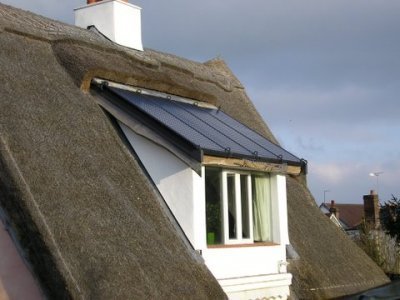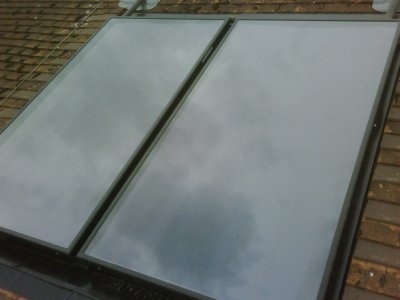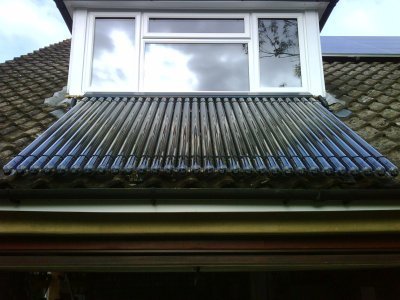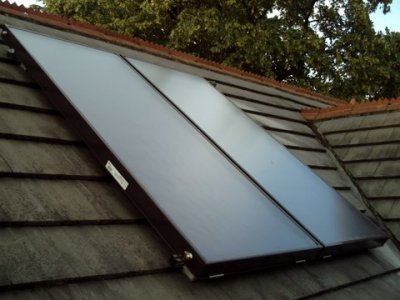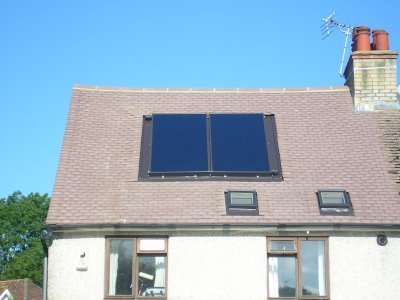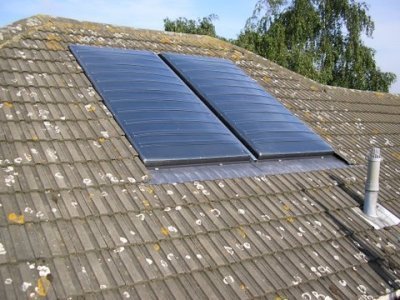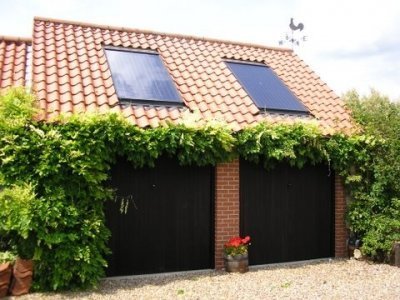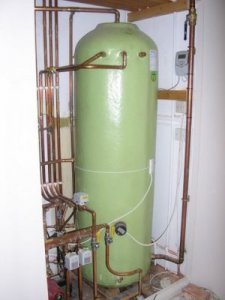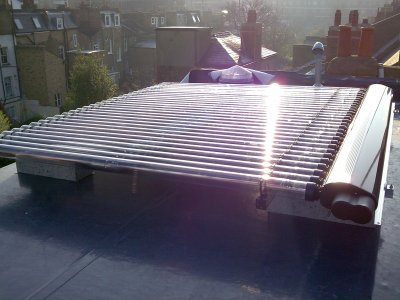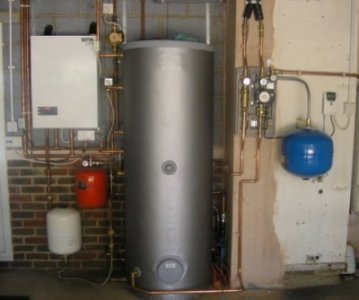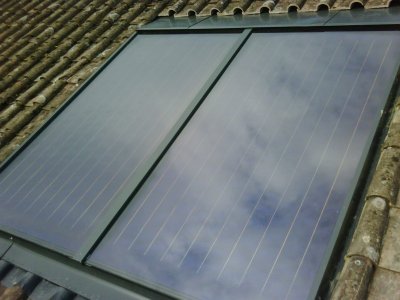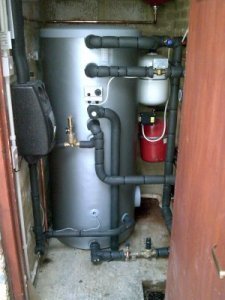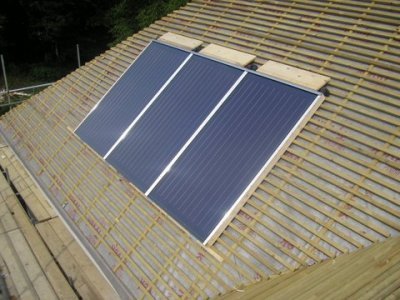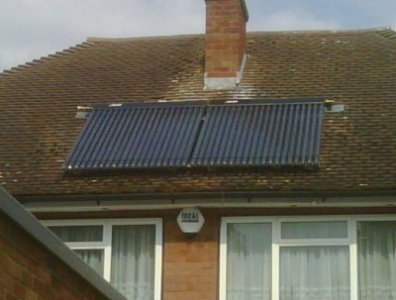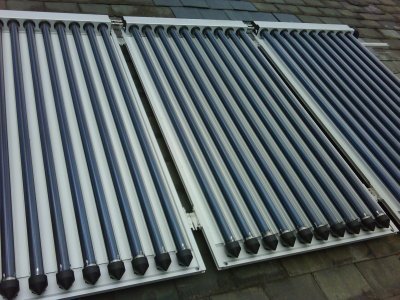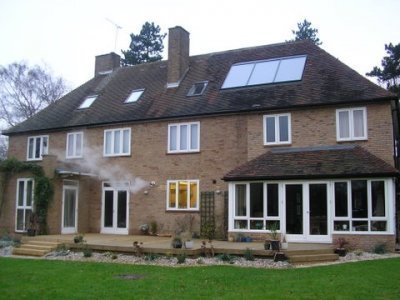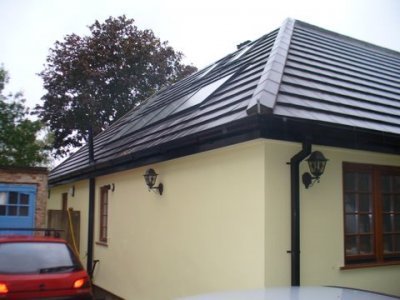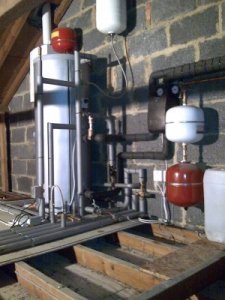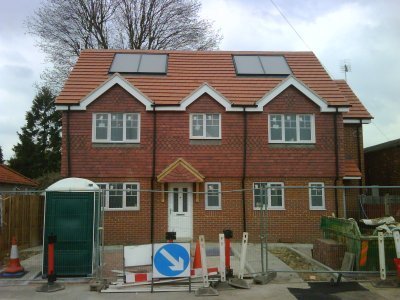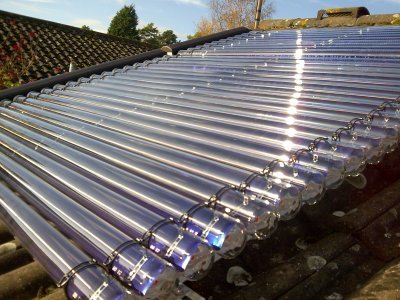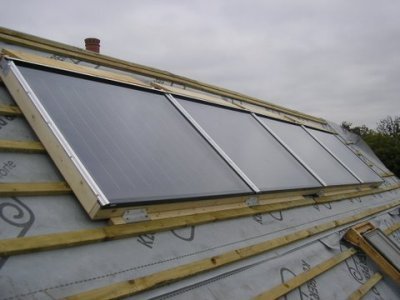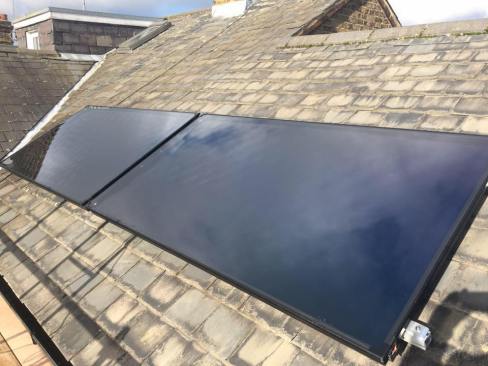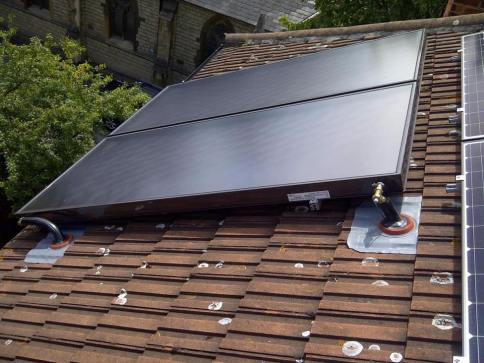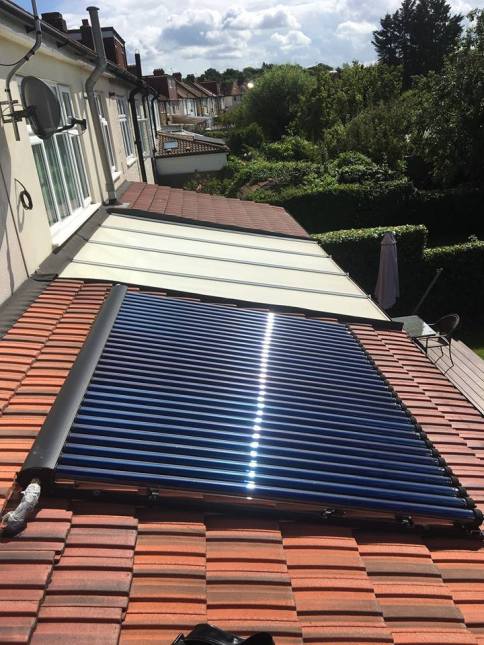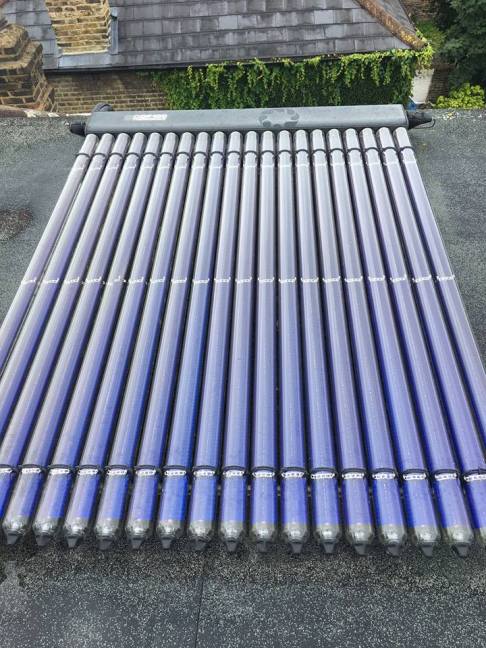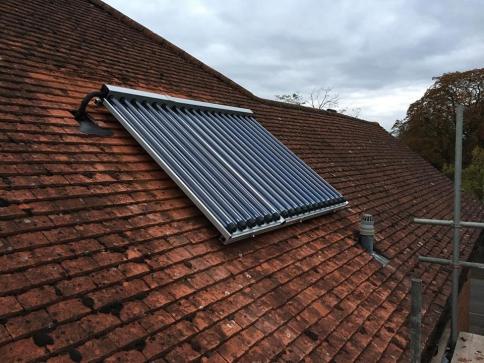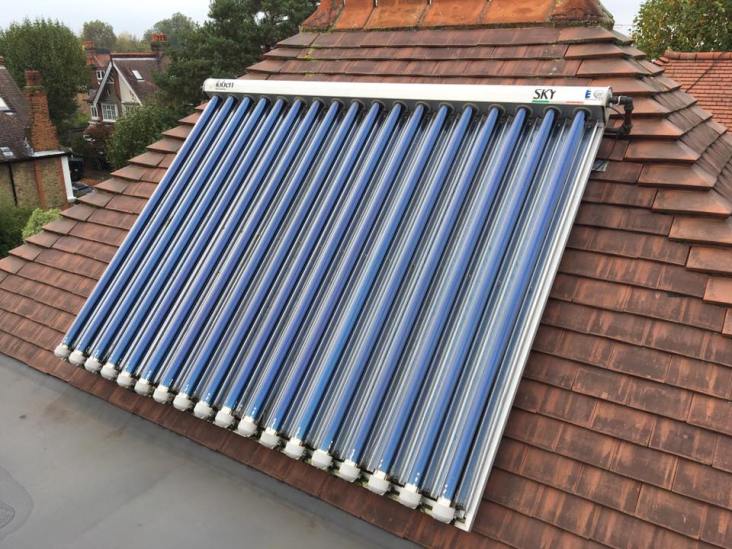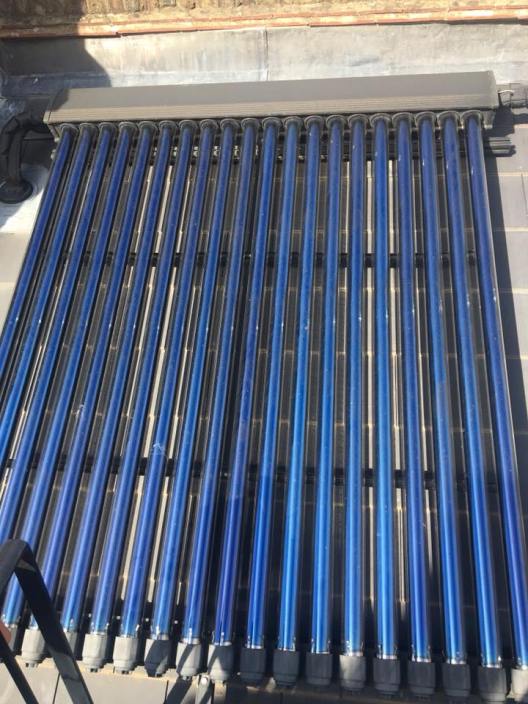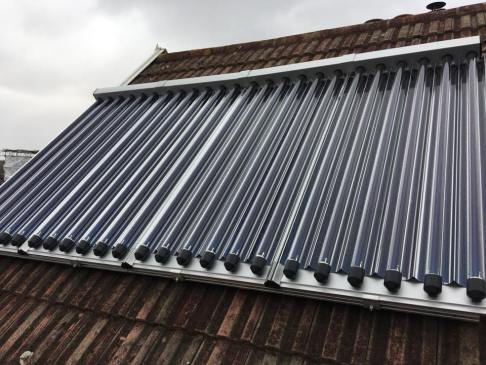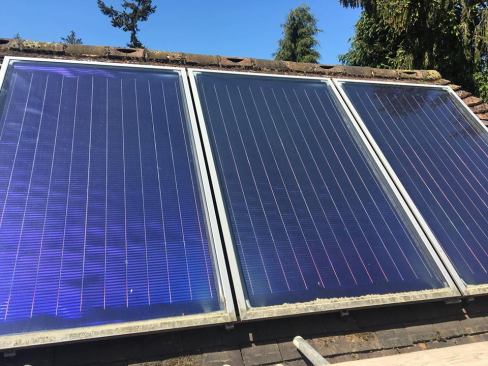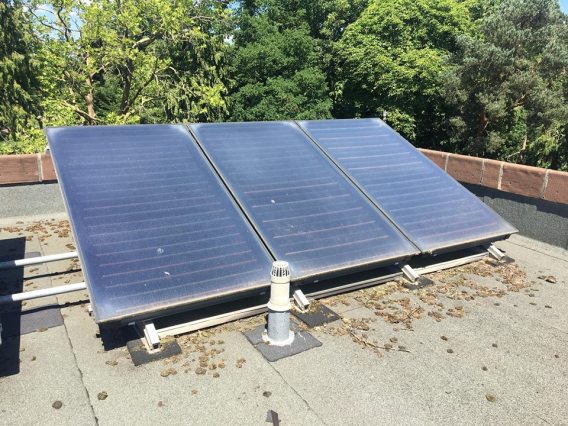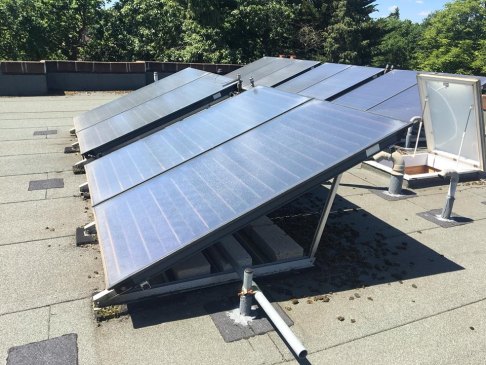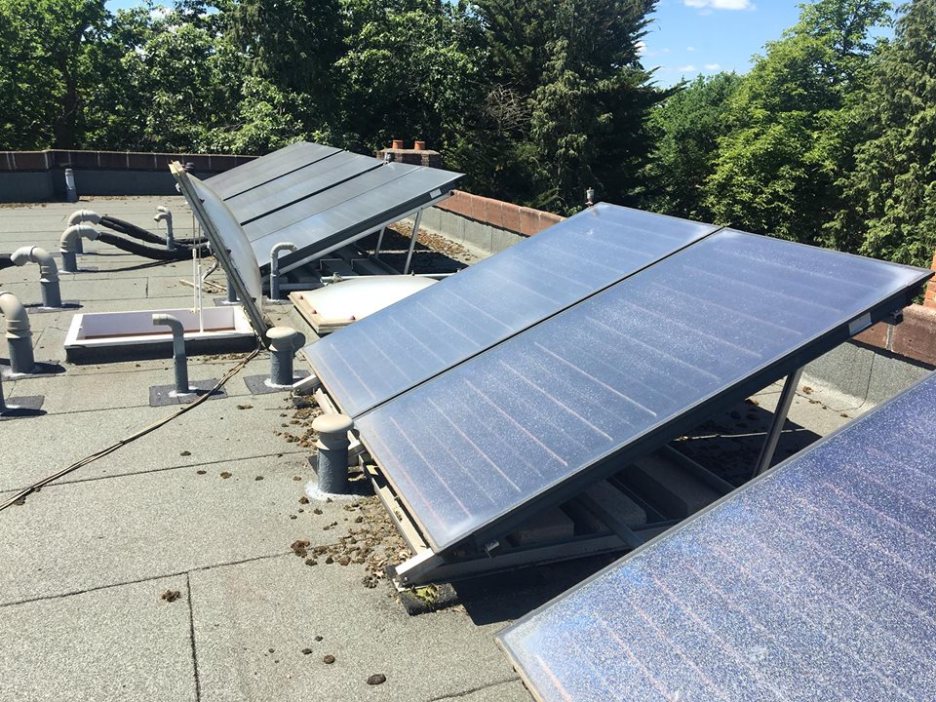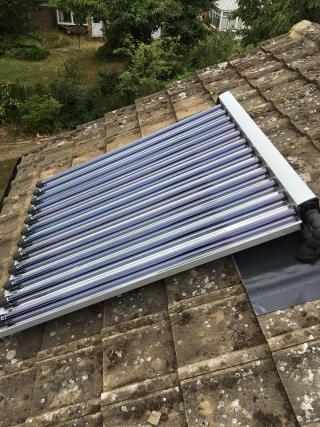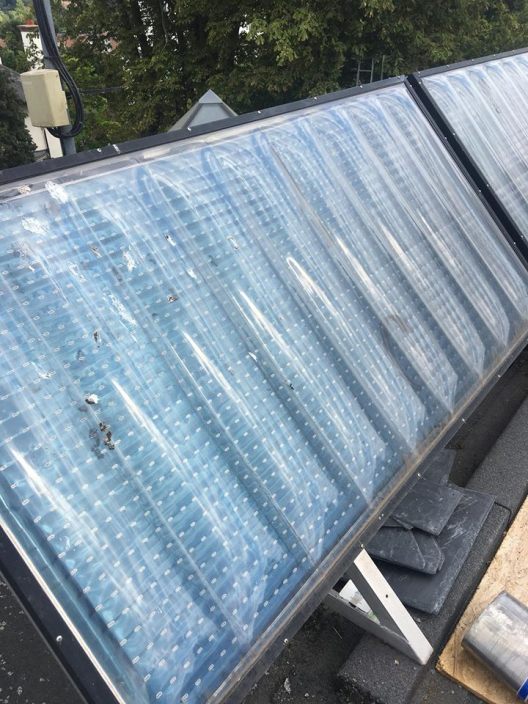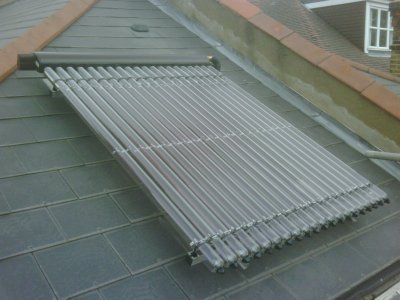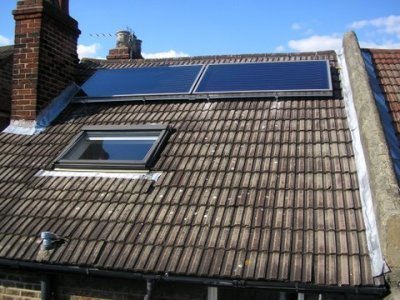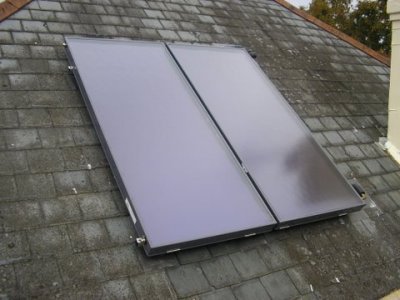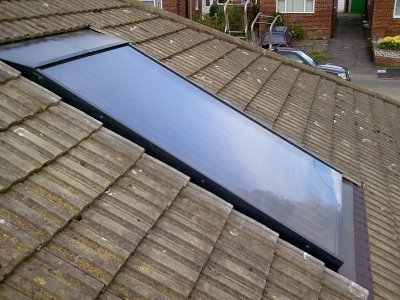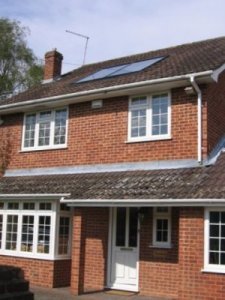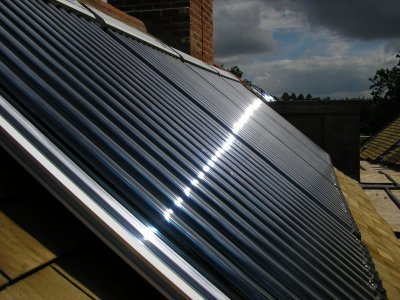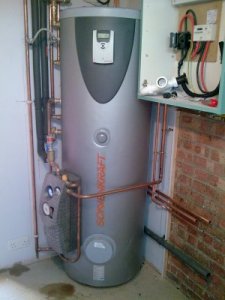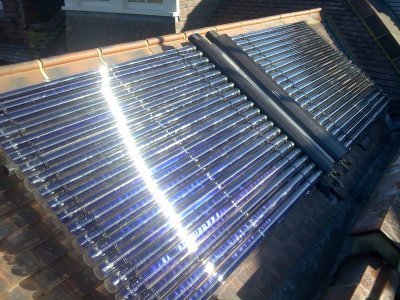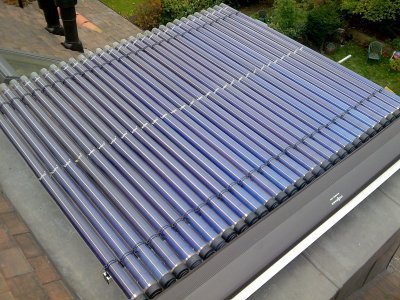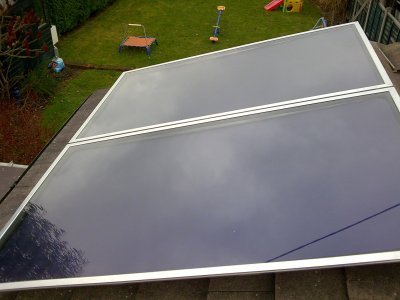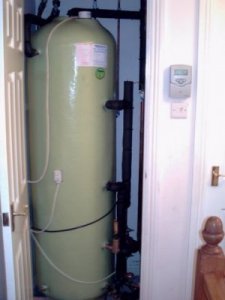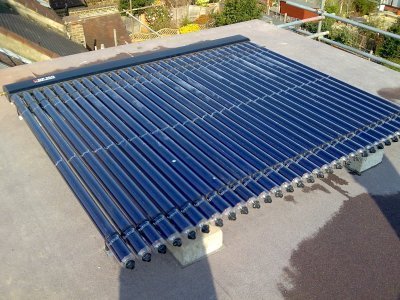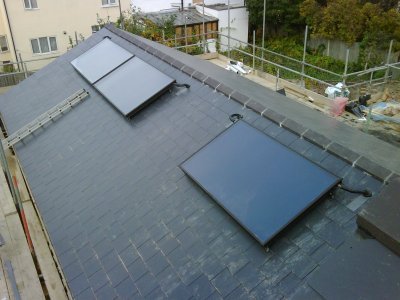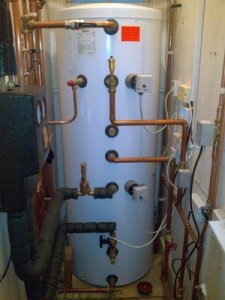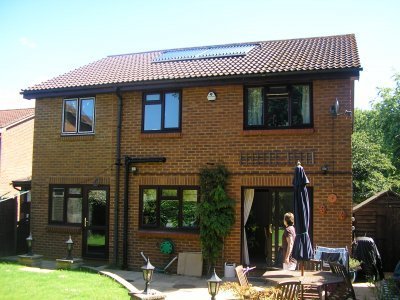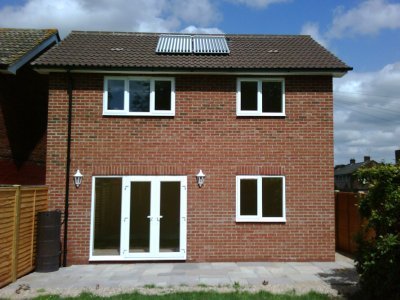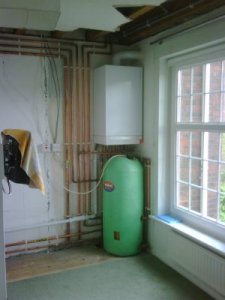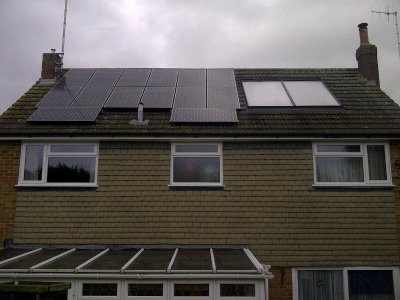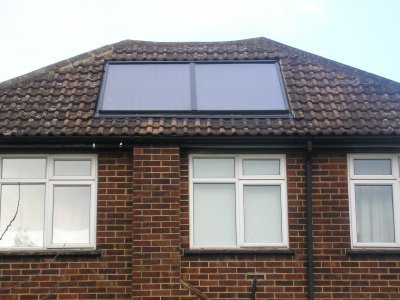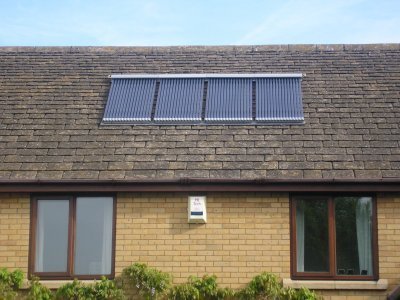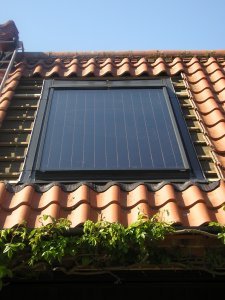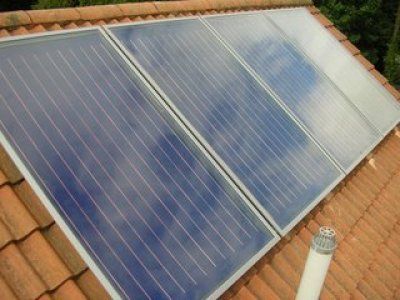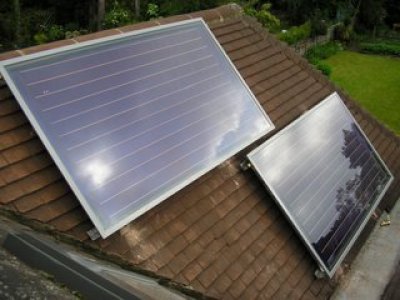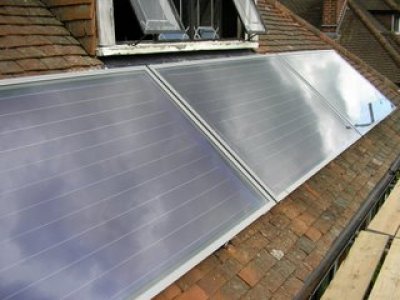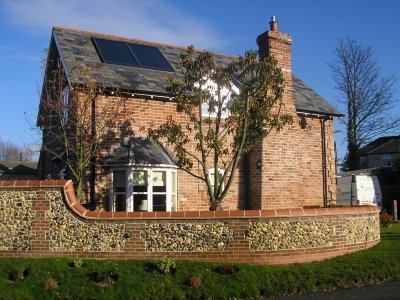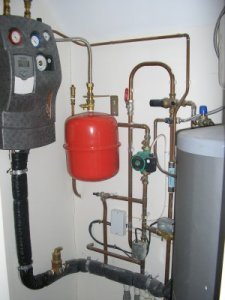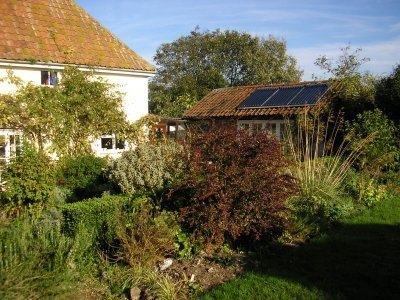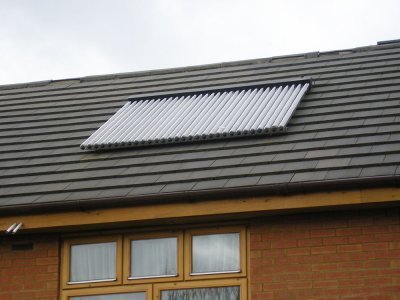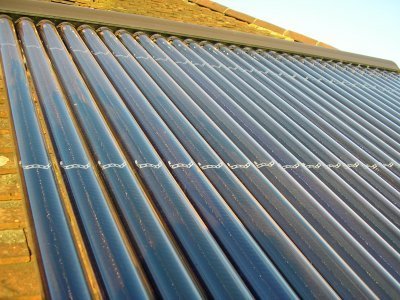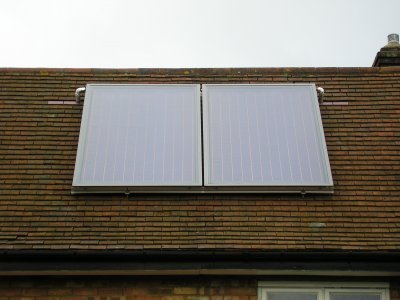Solar Water Heating
Solar water heating systems provide a cost effective solution for heating the water used for washing and bathing.
Solar Water Heating Systems
- Provide 70% hot water per year for 30+ years
- Fully automated and require no user intervention once installed
- Solar Collectors can be mounted on the roof, in the garden or on walls
- Indirect system, no scale or frost damage
- System designed with T*SOL solar software showing system outputs & savings
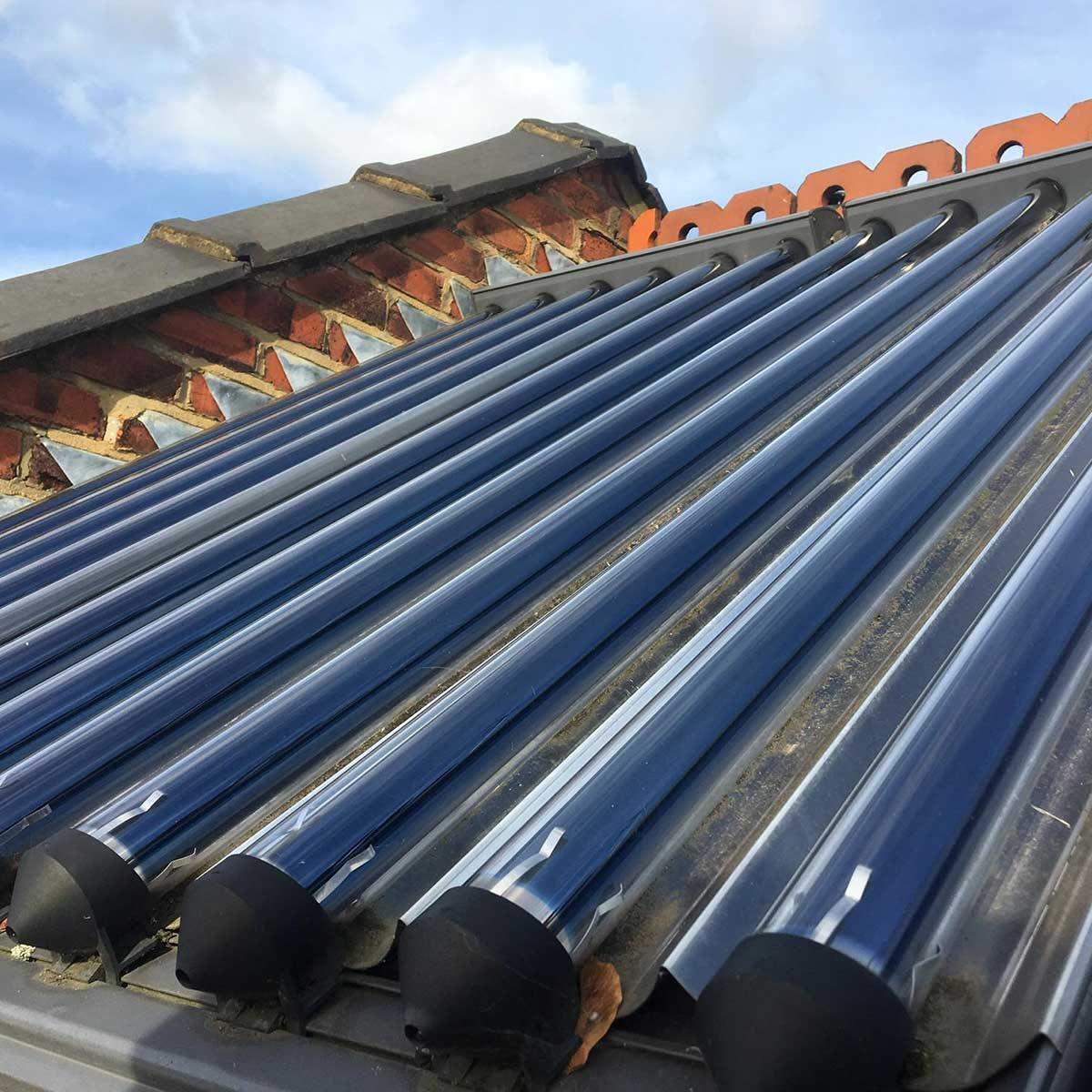
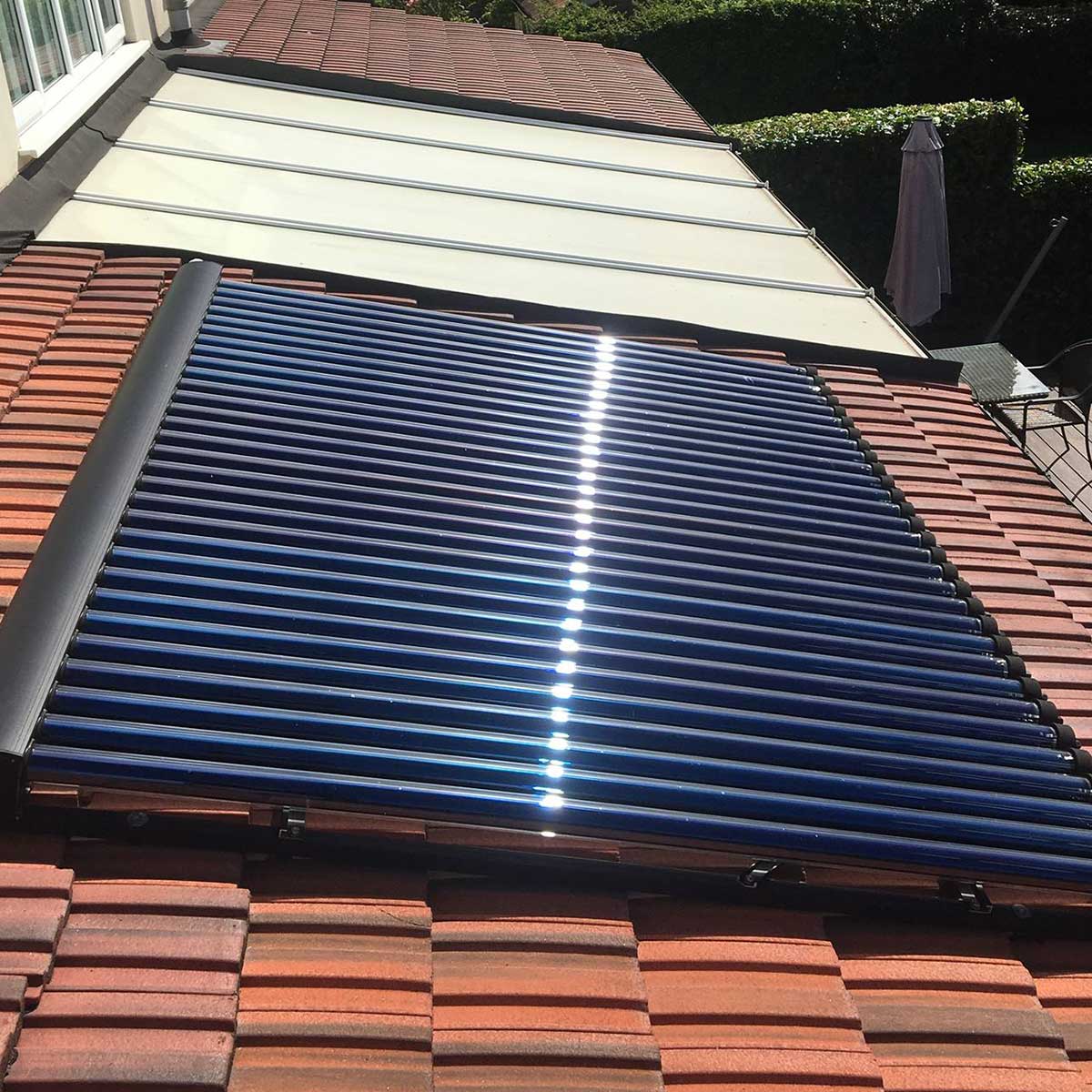
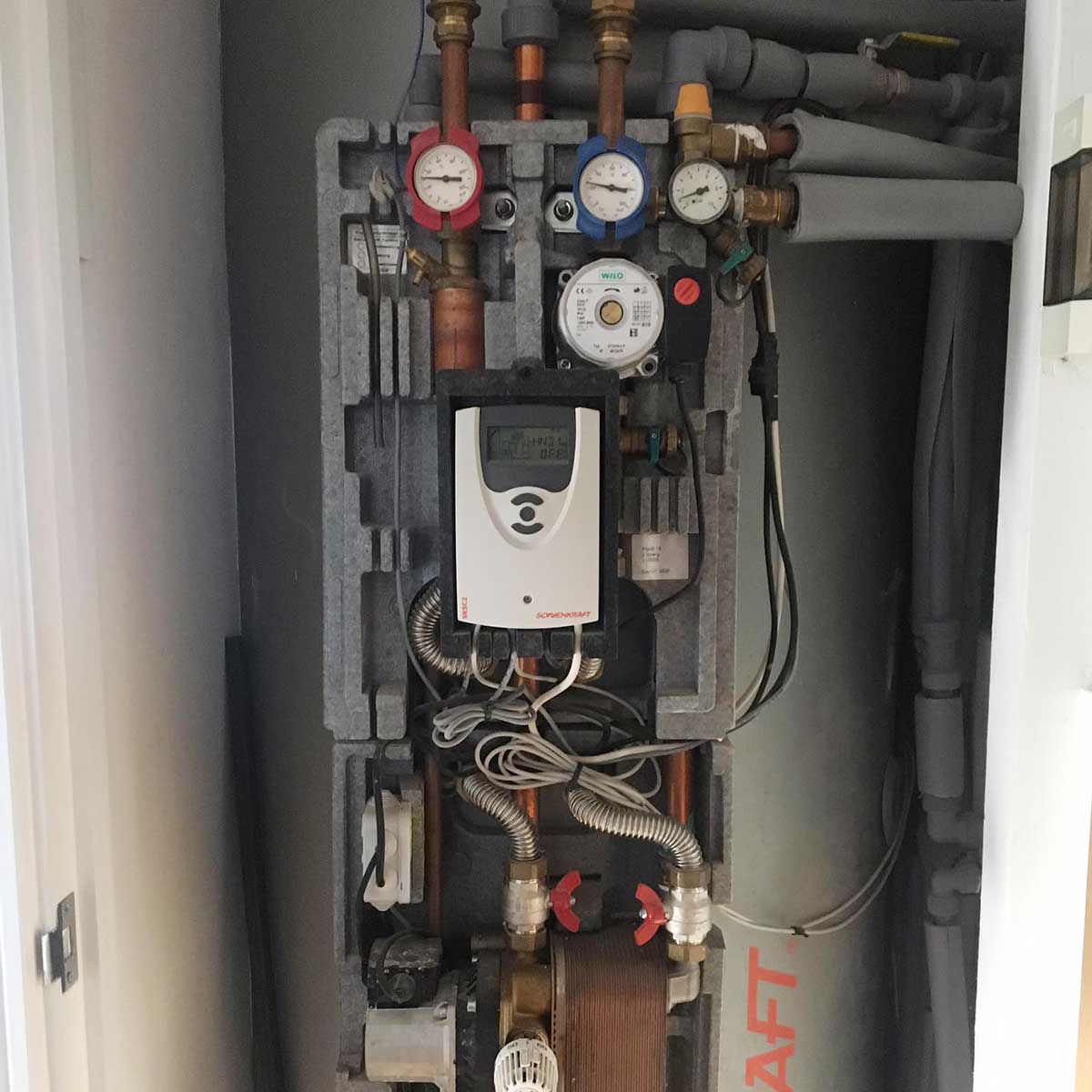
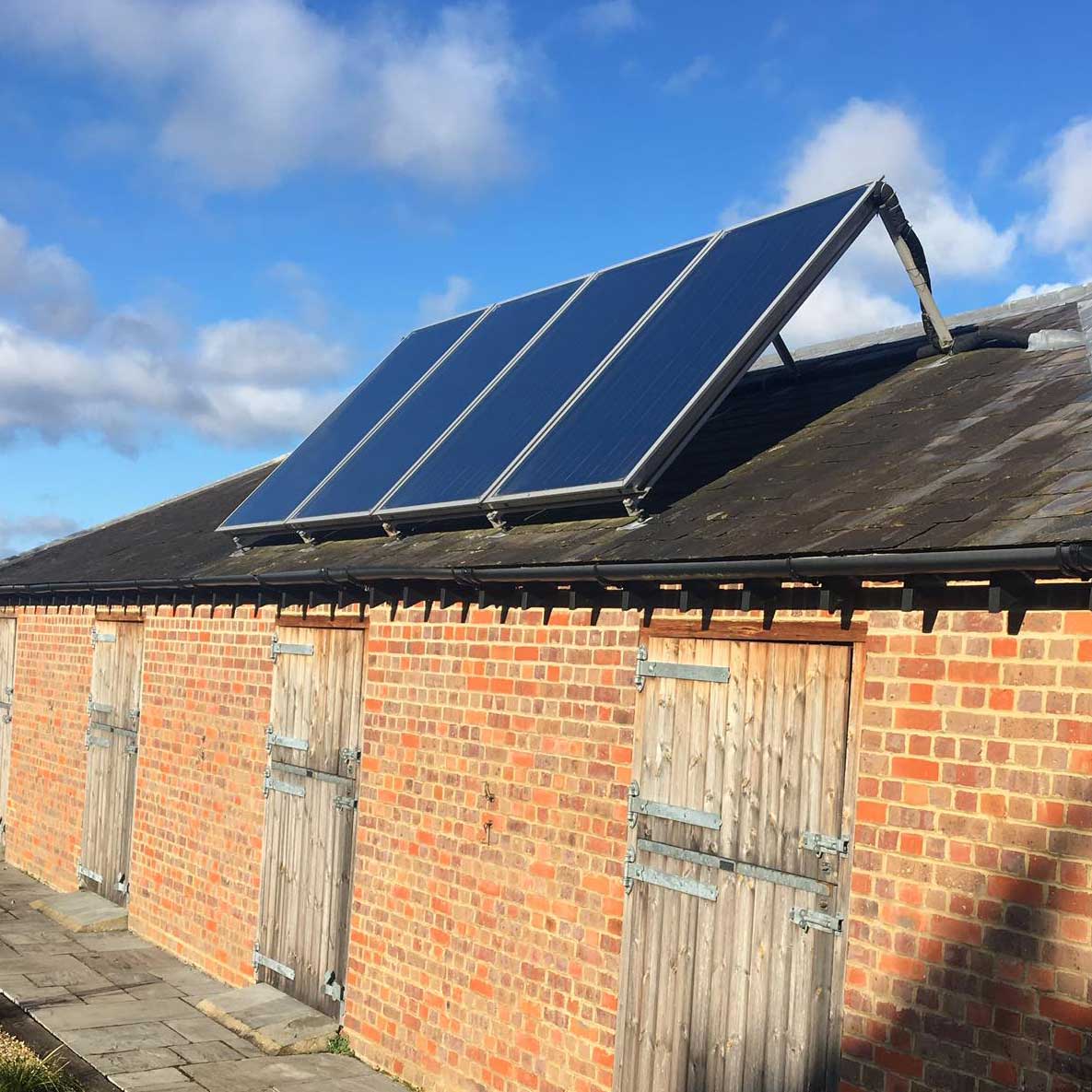
A Solar Water Heating System works like this…
An electronic solar heating controller constantly compares the temperature of the solar collectors (usually located on the roof of the building) against the temperature of the water in the bottom of the solar hot water cylinder. Whenever the solar collectors are hotter than the temperature in the bottom of the solar cylinder, the solar controller switches on the solar systems circulating pump. A solar grade anti-freeze is then circulated through the solar collectors, moving the heat to the solar cylinder’s heat exchanger, heating the water inside the solar cylinder in a similar way to a central heating boiler.
Up to 95% Solar Hot Water coverage from May to October
Our clients have informed us that the solar heating systems we have installed will usually heat all of their daily water consumption from May to October. Outside of these months they still get a satisfying amount of heat from the solar system on clear and cloudy days. You should expect, on average 90% to 100% in the summer, 50% to 60% during the spring and autumn and 25% to 35% in the winter.
Correct sizing is essential for solar
Size of solar collector area and solar cylinder depends on how many people you will need to supply. In a domestic situation if you want 70% of your hot water supplied by solar expect the following sizes for flat plate systems.
- 4m2 collector and a 200 litre cylinder for 1-2 people
- 5m2 collector and a 300 litre cylinder for 2-4 people
- 7.5m2 collector and a 400 litre cylinder for 3-5 people
- 7.5m2 collector and a 500 litre cylinder for 4-5 people
- 10m2 collector and a 500 litre cylinder for 5-7 people
- 12.5m2 collector and a 750 litre cylinder for 8-12 people
- 15m2 collector and a 1000 litre cylinder for 12-20 people
Vacuum Tube solar collector area will be slightly smaller, cylinder capacity would remain the same. It is always best to install the largest system possible because the solar will supply you with more energy. If your going to invest in solar hot water you should do it right in the first place and get the correct sized system installed.
Q&A Domestic Solar Water Heating
What is a Solar Hot Water Heating system?
A Solar Hot Water Heating System or Solar Thermal System put simply is a solar panel system that heats water. Usually you will have solar panels installed on the roof or on a frame at ground level and a hot water cylinder installed near to the panels. The solar panels heat up when day light (the Sun’s radiation) falls onto them. This radiation heats up a liquid inside the panel, usually anti-freeze. This heat is then transferred by the heat transfer medium (the anti-freeze) to your cylinder or pool heat exchanger. You can then use this heated water in your cylinder to wash, heat your home or pool.
Is Solar Hot Water Heating suitable for use in the United Kingdom?
Our solar systems are designed to work in northern Europe, a well sized solar thermal system can supply 70% of your hot water per annum, sometimes slightly more. This means that if you take an average from all the days throughout the year the amount of energy saved by the solar system could be 70% of your water heating energy consumption. This doesn’t mean the solar system will supply 70% of your hot water every day throughout the year without fail, we are talking averages. It is possible with a combined pool and water system to get around 80%+ of you domestic hot water per annum. Solar Thermal systems work very well in the UK.
Does a solar thermal system work in the winter?
Yes it does work in the winter, supplying you with a percentage of your hot water consumption rather than all of your hot water needs. This is why the systems are so effective. The solar systems work all year suppling you with hot water, even in the cold winter months the solar system will be providing some energy. The system will need to be backed up with a boiler or immersion heater for the months when it is cooler and darker. It will not work when it’s foggy, snowing, raining or overcast. A solar panel will not work when the weather is miserable.
Solar assisted underfloor heating systems produce the most useful energy for space heating in the Spring and Autumn seasons.
What % of solar coverage can I expect per month with a Viessmann solar hot water system?
When you are supplied with a quotation you will also be supplied with a T*SOL solar system simulation that is site specific, so your project solar coverage wil vary from the figures shown. The figures below are averages sourced from Viessmann.
- January = 24%
- February = 41%
- March = 62%
- April = 75%
- May = 86%
- June = 86%
- July = 89%
- August = 86%
- September = 83%
- October = 59%
- November = 29%
- December = 24%
Total Annual Coverage = 60%
Do I need planning permission for the solar panels?
Since April 6th 2008, all homeowners are able to install solar panels without needing to get planning permission if the property is not a listed building or in a conservation area.
A solar panel is just a radiator painted black in a box on the roof, isn’t it?
No. A Solar Panel or Solar Collector isn’t a radiator painted black. This is where solar collectors today differ greatly from solar panels in the past. A solar collector is very efficient at turning light into heat, there is a special coating called an Absorber Surface Coating that is spluttered or fused at a very high temperature with the metal sheet inside the solar collector, it’s this surface that makes the collector so efficient and so effective.
How and where are your solar panels made?
The solar panels are made in the UK and Germany. All good panels are made from a strong aluminium body that will not corrode. A toughened solar glass screen or tube that does not break under hail conditions and/or heavy snow loads and a highly efficient absorber surface coating spluttered (fused) onto the absorber itself. The panels are also insulated with kiln dried glass fibre.
Are your systems Flat Plates or Vacuum Tube?
We install flat plates and vacuum tube collectors but each installation is looked at individually. The flat plates have more merit if the solar panel is going to have any planning issues and will need to be integrated into the roof. Flat plates are also more robust and are more suited to heating hot water. Our vaccum tube systems do give a slightly better output annually, probably about 5% compared to our flat plate systems output on the same sized cylinder and the panels can be mounted in slighly smaller spaces.
As well as vacuum tubes, flat plate collectors also work on cloudy days, in fact all solar collectors work on cloudy days. If you compare flat plates and evacuated tubes by m2 for m2 of aperture area some, yes only some vacuum tubes panels are more efficient than flat plate solar panels. But if you look at costs per solar panel, collector or system you typically have a much larger absorber surface area on a flat plate system so for a similar cost you would normally expect a simlar output (about 5% difference in yield per annum) from our flat plates as you would our vacuum tubes.
Orientation of flat plate collectors isn’t a problem and vacuum tubes have no benefit over flat plates except on an east facing or west facing elevation where vacuum tubes would be more desirable, especially for winter use. Vacuum tubes can also be installed flat on a flat roof or flat onto a gable-end wall.
As a rule of thumb you would expect a good vacuum tube system with 3m22 aperture flat plate system.
PLEASE NOTE: A good flat plate has a higher output per m2 of aperture area than a poor vacuum tube panel, and there are lots of poor vacuum tube panels for sale at present.
Other solar company’s that aren’t so honest or with less experience might tell you that vacuum tubes are brand new, very exciting and are ‘super’ powerful and are more powerful than all flat plates. Unfortunately they are falling victim to their suppliers marketing blurb or wishing that you fall victim to their marketing ploy…Beware! Never sign on the dotted line after a 3 hour sales pitch from a solar salesman, you’ll be conned.
Do your vacuum tubes have a mirrored reflective plate behind them?
Not they don’t. The a vacuum tube panel with mirrored reflective plate is called a parabolic collector. The design is flawed because the mirrored reflector dulls over a short period of time. The output from collectors such as this will drop by around 15% shortly after installation.
How much does a solar hot water heating system cost?
A fully installed solar water heating system for a small bungalow will cost in the region of £3,800, for a family home £4,800 and for the larger home £5,800+. Price varies depending on scaffolding, cylinder type, grant, amount of people to be supplied and vacuum tube or flat plate systems etc. From 2011 there will be a yearly grant for 20 years. Installations now will be eligible for the annual grant.
What grants are available?
There is the feed in tariff from the RHI which could be £400 per year for twenty years easily paying for the cost of an installed system. The final details are yet to be confirmed.
Why does solar thermal get a lower rate of return under the proposed RHI?
Solar thermal is a well-known technology, and it’s relatively easy to install. There are fewer barriers to overcome, so the RHI doesn’t think they need to give as high a return. They believe that it’s important to keep the costs of the scheme under control, especially since solar thermal is – per unit of heat – the most expensive technology to support. 6% rate of return is still more than people will generally get in their savings account. It’s a massive increase in support compared to what was available previously through our grant schemes (Low Carbon Buildings Programme). Where previously a householder would likely have received a one-off grant up to £400 in total, under the RHI they could get that much every year for 20 years.
Solar Thermal up to 20kW will get an annual grant of 18p/kWh for 20 years.
Solar Thermal from 20kW to 100kW will get an annual grant of 17p/kWh for 20 years.
Another company is offering solar systems cheaper than yours, how?
To offer systems cheaper they make them smaller or reduce the quality of the installation. Our systems are sized as close as possible to get you 70% of your hot water energy demand. We can install cheaper systems like the other company but we would put in a smaller cylinder and put on two small flat plates or two small vacuum tube modules just like the other company does. You will still have a good quality solar system but it sized to only heat 40% or maybe 50% of your hot water per annum. The other company will still claim that you’ll get “up to 70%” of your hot water per annum but you won’t, not with a system that small.
I’ve been offered a system by another company, can you better it?
We certainly can. Solar Thermal UK has been installing solar systems for many years so would of probably installed the kit the other company is selling. We will be able to get or will already have the test reports of their panels and will be able to simulate their proposed system with our software. We can simulate their system design and will be able to beat it with a better system every time.
If I have a bigger solar cylinder won’t just I have to heat more water up?
No you won’t. The solar cylinder is really well insulated and hardly looses any heat. All the pipework connected to the cylinder will also be insulated so you will not be loosing any heat there either. If the cylinder is sized well a full cylinder of heat will last two days. If you do need a top up from the boiler or immersion heater you will be heating up warm water not cold water as you would if you installed a small hot water cylinder. If you install a small cylinder you will use all the hot water and be left with cold water. It takes more energy to heat cold water to hot water than warm water to hot water. The larger the cylinder the less energy it will take to heat the water because you will have a stored volume of hot/warm water.
Does a solar panel work at night?
Unsurprisingly, even with a full moon, a solar panel does not work at night!? (Yes, we have been asked this before!)
What’s the difference between in-roof and on-roof panels?
In-roof or roof integrated panels are fitted in with the tiles and come with a flashing kit. Roof integration is ideal for new builds because the panels can be fitted onto the roof as the roof is being built. If the client wishes to have roof integration on an existing building a scaffolding will be erected and part of the roof area will be stripped of tiles. The solar panels will then be mounted onto the roof batons and flashed. The tiles will then be re-laid on the roof and cut to fit if need be. When a system is installed like this the pipework is hidden within the flashing kit and the finished panel installation looks very neat.
On-roof or Roof mounted panels don’t come with a flashing kit because the solar panels sit above the tiles on a sturdy aluminium frame. The frame is bolted to the rafters that support the weight of the roof and the frame stands proud of the tiles creating an air gap. The panels are then fixed to this frame. The flow and return pipework is then connected to the sides of the panels and installed through a lead slate and into the loft space. When the installation is finished you will be able to see a small amount of pipework and insulation to the left and right side of the panel. You will also see the frame and roof fixings that are aluminium/stainless steel in colour. Please see the pictures of solar panels installations to see the difference for yourself.
I haven’t got a south facing roof, can I still have solar?
Not having a south facing roof or a south east or south west facing roof is no problem. You have a few choices depending on your project. The first is an east/west split where collectors are installed on the east/west elevations of the roof to collect the Suns energy as it moves through the sky. In the morning the east collector will work, midday both collectors will work and in the afternoon the west collector will work. Another option is flat roof mounting where a vacuum tube solar panel can be installed flat on a flat roof or you could install at 90* on a gable end wall. You also have the option of installing on ‘A’ frames in the garden. Systems installed like this have a sligt drop in efficientcy so slightly over sizing the solar collectors makes up for this. There is always a solution.
Can a Solar Hot Water (Thermal) system power the lights or T.V?
No. A Solar Thermal System only heats water, another type of solar system produces electricity to power your electrical appliances, it’s called a Photovoltaic System or P.V System.
How do you work out what % gets supplied by solar per annum?
We use solar thermal simulation software to do this for us. We enter the location of your house, number of occupants, brand of solar collector, position on the roof, direction, hot water consumption, distance from solar panels to cylinder, insulation used etc, etc, all site specific information to build a picture of your project. We then run a few simulations and select the best system for you. The report we issue with the quotation gives a % supplied by solar as well as kWh saved, units in gas, litres in oil, electricity or biomass fuel saved and CO2 saved. Each simulation is different but usually the solar coverage is around 55% to 70% per annum with a target temperature of 50°C. Sometimes it’s as high as 80%! We supply and install excellent systems.
Can the solar thermal system be powered by solar electricity?
We can design a solar thermal system to be powered by PV. It is ideal for remote applications or for people who wish to have a zero carbon solar thermal system.
Doesn’t a Solar Thermal system need bright sunshine to work?
A Solar Thermal system needs daylight to work, not direct sunlight. This means a modern solar collector works by collecting direct and diffuse solar radiation. Direct means the Sun shining onto a surface, the heat you feel on your skin. Diffuse means the Sun’s rays getting through the clouds and reflecting off of other surfaces. Any solar collector works on the intensity of the Sun’s radiation getting through to the Earth. The stronger the Sun the more the solar panel will work. You will collect energy on a clear summers day but you will also collect some energy on a cloudy winters day. Thermal systems now are much more efficient than they were years ago. As a rough guide you will should expect energy to your cylinder on a sunny days and white cloudy days. You should not expect much energy on grey cloudy days. When it’s raining, foggy, snowing, at night and general bad or miserable weather conditions you should expect no energy.
What’s the difference in the intensity of the Sun’s rays in Watts in various weather conditions to the surface of the Earth?
Broken Cloudy Day = 600W/m2
Overcast Day = 300W/m2
Heavily Overcast Day = 100W/m2
A solar collector can use a % of this available heat to heat your hot water. The % collected by the solar panel will be affected by the tilt angle of the solar panel, the direction the panel is facing, shading and panel efficientcy.
What is the heat output from a solar thermal system?
The maximum output from a domestic flat plate solar hot water system (on a clear summer day) is approximately 700W per m2 aperture area. Our flat plate systems for 3 to 5 people have a gross collector area of 5m2 but an aperture area of 4.4m2. So 4.4m2 x 700Wm2 = 3.08kW. So a system of this size would have the same output as a 3kW immersion heater typically found in hot water cylinders. At maximum output of 3kW it would take just over 5 hours to heat 250 litres of water from 5 to 55 degrees C.
The maximum output from a domestic vacuum solar hot water system (on a clear summer day) is approximately 1kW per m2 aperture area. Our vacuum tube systems for 3 to 5 people have a gross collector area of 4.5m2 but an aperture area of 3m2. So 3m2 x 1kWm2 = 3kW. So a system of this size would have the same output as a 3kW immersion heater typically found in hot water cylinders. At maximum output of 3kW it would take just over 5 hours to heat 250 litres of water from 5 to 55 degrees C.
What is the annual energy yield from a solar thermal system?
Every installation is different and every collector brand is made slightly differently so this will effect the annual energy output. In the South of England ‘Green Systems’ flat plate collectors give around 377kWh per m2 and our vacuum tube collectors produce around 519kWh per m2. This figure is heat to the heat exchanger allowing for pipe and pump heat losses on the way in an average home. This figure is also in relation to the aperture of the collector which is the opening that collects the Suns radiation, not the gross surface area of the solar collector. All quotations come with their own system design and calculations so you will know exactly what you will be getting.
Suppose there’s not enough Sun to heat the domestic hot water?
The most user friendly way of operating your boiler with the solar system is to have the boiler timed to come on and heat your domestic hot water at dusk. The easiest option for the user to have this set all year round. This way the solar is free to work all day without hindrance from the boiler. If the solar has heated your hot water to 65 degrees C or above your boiler will not come on, or will just heat your radiators if this function is selected on your central heating controller. If the solar has heated your cylinder to 35 degrees C the boiler will come on, top up the domestic hot water by 30 degrees to 65 degrees C and then turn off. Or if you have your central heating on it will then just work on your central heating. There will be days, even in the summer, when the solar system will deliver no heat to your cylinder due to the weather. It is advisable to always have your boiler timed to come on at dusk to avoid a no hot water situation.
How do Solar Thermal systems for domestic hot water work?
The collector (solar panel) is usually installed onto the roof of the house or on ground mounted frames. The hot water cylinder can be placed anywhere in the building, only the solar panels need to be on the roof to collect day light. An electronic controller constantly compares the temperature of the solar collectors with the temperature of the water in the bottom of the cylinder. Whenever the collectors are hotter than the temperature in the bottom of the cylinder, the controller switches on the solar systems circulating pump. A solar grade anti-freeze is then circulated through the collectors and the cylinder’s heat exchanger, heating the cylinder in just the same way as a central heating boiler. With both systems the anti-freeze never directly mixes with the water in the cylinder. They are called in-direct systems, it is essential to use an in- direct system as this eliminates any problems with frost and ice splitting the solar panels or hard water damage.
Am I at risk from Legionella?
As with conventional domestic water heating systems, it is always a good idea to heat your hot water to 65 degrees C before use. This eliminates the very small risk from Legionella bacteria that can infect any hot water system and may cause Legionnaire’s disease in susceptible people (less than 5% of the population). This simply requires the setting of the water heating thermostat on your cylinder to 65 degrees C so that all water is brought up to this temperature and kills the bacteria before use. It is advisable to have your system set to carry out this task on a daily basis. There have been no Legionella cases linked to domestic solar water heating in the UK.
What is a Pressurised Solar Thermal system?
A pressurised solar thermal system is a very efficient type of solar thermal system. They are designed in a similar way to a pressurised central heating system with an expansion vessel, pressure relief valve and pressure gauge. The liquid inside the solar system can oporate safely at temperatures in excess of 100°C without boiling or vapourising because the liquid is under pressure so the boiling point is raised. Pressurised solar thermal systems should always be filled with a solar grade antifreeze and because of this will still work at -28°C. Our pressurised solar thermal systems collect the most energy.
What is a Drain Back system?
The Drain Back is a system that empties the collector when it is not in use. All the heat transfer medium drains away from the collector leaving it dry, this prevents the collector from boiling or freezing. There is less that can go wrong with a drain back system because there are less moving parts but there’s also a drop in efficiency compared to our pressurised systems.
What is a freeze tolerant system?
A freeze tolarant system is a system that will tolerate being frozen so no anti-freeze is used and the panels are usually direct, so the water in the cylinder is passed through the panel. These systems have a more “DIY” feel and are more prone to scale than indirect systems such as the ones we offer. If you require this type of system please send a request so via email or telephone and we can advise you on the best solution.
If solar’s so good why isn’t it included on all new builds?
Part L of the Building Regulations deals with the conservation of fuel and power for buildings in England and Wales. Part L was revised in April 2006 to raise overall energy efficiency standards. The improved standards mean that developers need to consider using low or zero carbon systems (LZC), such as solar panels, to demonstrate compliance.
However, because the regulations set functional requirements, which the individual aspects of a building design and construction must set out to achieve, particular technologies are not demanded in new homes. This performance based approach offers designers the flexibility to choose solutions that best meet their needs, and that are both cost-effective, practical and allow for innovation.
On 23 July 2007 the Government confirmed its timetable for the move towards zero carbon homes, via a planned major progressive tightening of the energy efficiency standards in the Building Regulations, up to the zero carbon target in 2016. There are indications are that LZC technology will increasingly be needed to achieve compliance.
How much of my whole energy bill is hot water heating only?
Approximately 25% of your energy bill would be for hot water heating, 57% for room heating, cooking 7% and lights & small scale consumption 11%.
It is worth noting that central heating is only a seasonal demand where hot water demand is constant throughout the year. The solar system can provide a reasonable amount of heat to the space heating system as well as the hot water system in the Autumn and Spring periods.
Can Solar Thermal system heat my radiators?
Yes it can give you a % of heat to radiators but it is more suitable when installed with underfloor heating because this runs at a lower tempertaure. It is possible to heat your home by solar but it is unlikely that you would install the system because of cost. We have visited concept solar system installations in Austria where the low energy eco homes were 100% solar heated. This required very high levels of insulation, triple glazing and underfloor heating in a thick concrete screed that was used to store the heat. It is easier and more cost effective to assist your boiler with solar.
How does a Solar Thermal system that heats underfloor heating (UFH) work?
An electronic controller constantly compares the temperature of the solar collectors that are usually located on the roof of the building with the temperature of the water in the bottom of the thermal store water cylinder. Whenever the collectors are hotter than the temperature in the bottom of the cylinder, the controller switches on the solar systems circulating pump. A solar grade anti-freeze is then circulated through the collectors to the cylinder’s heat exchanger, heating the cylinder in just the same way, but not as quickly, as a central heating boiler.
The water in the cylinder is then diverted to the underfloor heating system by the use of a valve that monitors the temperature of the return water to the boiler. If the temperature of the return water to the boiler is cooler than the temperature of the water in the thermal store then the valve will divert solar heated water through to your space heating system assisting your boiler.
With a solar assisted domestic UFH system you will need a thermal store cylinder of at least 1000 litres or larger and a very large collector area at a steeper inclination angle than a domestic hot water system. A 60 to 90 degree incline is essential for better performance in the winter months. Any solar heating system designed to a smaller specification than this will have very little effect IE <10% assistance to the heating system.
Can a Solar system heat my Pool?
Solar is well suited to heating swimming pools. We install the new advanced glazed collectors and vacuum tubes, they are much more efficient at heating swimming pools than the traditional ugly black poly swimming pool collectors that you might of seen before. We need a smaller area of collector because they are more efficient and the system is better at heating the pool water in the colder months because the collectors have a selective coating that absorbs light and are insulated so loose much less heat.
How do solar swimming pool heating systems work?
An electronic controller constantly compares the temperature of the solar collectors, usually located on the roof of a building or frames in the garden with the temperature of the pool water. The temperature of the pool water is measured in the pool pipework in the plant room. Whenever the collectors are hotter than the temperature of the pool water, the controller switches on the solar systems circulating pump. A solar grade anti-freeze is then circulated through the collectors to the new Bowman solar swimming pool heat exchanger. The heat exchanger is fitted to the pool pipework in the plant room or near to the filtration pumps, heating the pool in the same way as a boiler.
It would also be an advantage to design the pool with passive solar heating in mind. A dark coloured tile would draw more heat in and a transparent pool cover would also let light heat up the water when the pool isn’t in use. Designed like this the pool would act as a solar collector in it’s own right.
How do I look after a solar thermal system?
Once installed the system looks after itself. But like any other automatic system a regular check should be made to see that it is operating as it should be. A solar system is an intrinsically safe system but it should be treated like your existing gas or oil heating system. A check every other year is recommended from a suitably experienced engineer.
How long will a system last?
The average lifetime of a well designed and built solar thermal collector is over 35 years. At Green Systems UK we source only the highest quality, award winning solar systems that are recognized for their excellence throughout Europe and the World.
What are the guarantees with the solar thermal system?
Up to Ten years on collectors,up to Five years on parts, one year on labour and up to 25 years on cylinders
Do you give a 20 year anti-corrosion guarantee?
No we don’t because the materials the solar collector is made from don’t corrode. Any guarantee offering this would be a pure marketing gimmick.
How can I tell if a vacuum tube has lost its vacuum?
Firstly the vacuum in the tubes is rarely lost, so this shouldn’t really be of much concern. In order to maintain the vacuum in each vacuum tube a “Barium Getter” is used. This is a small metal device that fits inside the tube itself. During manufacture of the vacuum tube the Barium Getter is exposed to high temperatures which causes the bottom of the evacuated tube to be coated with a pure layer of Barium. This Barium layer actively absorbs any CO, CO2, N2, O2, H2O and H2 out-gassed from the evacuated tube during storage and operation, helping to maintain the vacuum throughout its service life. The Barium layer also provides a clear visual indicator of the vacuum status. The silver coloured Barium layer will change colour if the vacuum is ever lost, turning the end of the vacuum tube milky white. This makes it easy to determine whether or not a tube is in good condition.
Do you come out after the system is finished to check it’s working properly?
When we leave site the solar system will be working properly and we wouldn’t leave until it was. A fault with an existing system is very rare indeed and a check up after installation isn’t needed beacuse we install systems right in the first place. However if you request an after installation visit for peace of mind then we can call anytime you wish within the first year to make sure all is well.

